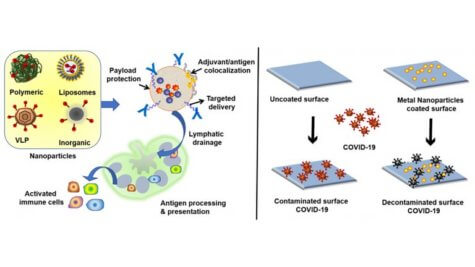WASHINGTON — As the world continues to fight tooth and nail against the seemingly ever-mutating coronavirus, many have already started to wonder what’s next. When will the next viral pandemic disrupt our lives? 50 years from now? 10 years? With that in mind, researchers in India say two new advances are being explored which could improve viral protection in both people and on surfaces which can carry viruses.
A team from the Indian Institute of Science report recent advances in both the nanotechnology and biomaterials fields may help produce more affective antiviral vaccines and or surfaces capable of detecting and killing viruses immediately upon contact.
“It is important not just in terms of COVID,” says study author Kaushik Chatterjee in a media release by the American Institute of Physics. “We’ve seen SARS, and MERS, and Ebola, and a lot of other viral infections that have come and gone. COVID has, of course, taken a different turn altogether. Here, we wanted to see how biomaterials could be useful.”
For reference, biomaterials refer to any material specifically engineered to interact with biological systems in a certain way. Drug delivery systems, surgical mesh, dental implants, and joint replacements are all examples of biomaterials. Nanotechnology, on the other hand, is the practice of building structures and devices at the microscopic level.
When will the next generation of antiviral tech arrive?

Researchers say these two technologies in combination may be the long-sought after key to more effective vaccines. They believe a vaccine created with biomaterial-based nanoparticles would be stronger than anything seen thus far.
“It is a means of stimulating the immune cells which produce antibodies during the vaccination,” study co-author Sushma Kumari explains. “It is like a helper, like priming the cells. Now, the moment they see the protein, the cells are more responsive to it and would be secreting more antibodies.”
These technologies also offer a world of potential when it comes to stopping viruses residing on physical surfaces. Right now several different strategies including UV light screenings help to disinfect surfaces such as park benches or restaurant tables. Study authors say newly conceived bioengineering technologies are laying the groundwork for self-cleaning virus killing surfaces.
“As viruses end up as droplets on various surfaces, the next person touching that could be picking up the disease,” Chatterjee notes.
Self-disinfecting technologies can potentially be applied in the future to create virus-killing masks, PPE suits, doorknobs, hospital beds, and any number of other items.
In conclusion, the research team says it is important to remember such technologies are still very new. A new vaccine or self-cleaning item won’t be released tomorrow, or even next month. Still, these advancements suggest future generations will enjoy greater resources and ways to stay safe when a new virus appears.
“Hopefully, this review and this kind of discussion will get researchers to think about how to use the knowledge that’s out there,” Chatterjee concludes.
The study is published in APL Bioengineering.
